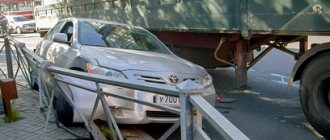Features of CASCO insurance
Unlike MTPL, the CASCO insurance policy is voluntary and can be taken out by the driver at will. The main distinction between the forms of insurance under consideration is possible liability. OSAGO covers damage caused by the culprit of the accident to other road users, while your own car will have to be restored at your own expense. CASCO has a different purpose - it protects only the owner’s car from almost any harm, even if it did not arise as a result of an accident. At the same time, CASCO does not insure liability in any way, and in the absence of compulsory motor liability insurance, other participants will have to compensate for the damage themselves.
The cost of issuing CASCO insurance is much higher, but the policy covers almost all possible damage. For both policies, the basis for providing compensation is the occurrence of an insured event. In compulsory motor liability insurance, an insured event is considered solely the fact of registration of an accident, while the driver himself should not be the culprit of the accident. In any other situations, the insurance company has the right to refuse to provide payment.
IMPORTANT !!! CASCO covers almost all situations resulting in damage to the car. In this case, it does not matter the circumstances of what happened (as part of an accident or not), as well as the fault of the driver himself.
Despite this, there are some rules, the violation of which will be the reason for refusal by the insurance company.
What should CASCO owners do in case of an accident?
The procedure to follow in case of an accident in order to file an insured event under a CASCO policy:
- Turn on the emergency lights (alarm), and then display the emergency stop warning sign.
- Call the traffic police at numbers: 02, 112 (for MTS), 911 (for Beeline), 020 (for Megafon).
- Stay at the scene until traffic police arrive. Do not remove broken glass or other evidence of an accident. Take photographs of the accident scene from all angles, documenting the damage to the vehicle.
- When creating a traffic jam, draw up an accident diagram, where, in front of witnesses, record the location of vehicles at the scene of the accident, and also write down the full name, contacts and addresses of witnesses.
- Consult your insurer (agent, broker) about this situation.
- Fill out accident notification forms together with all participants in the accident (attached to the CASCO policy).
- You should receive from the traffic police officers: a protocol on an administrative offense (original, or a copy) drawn up for a traffic violation violator;
- a certificate of car parts damaged in an accident (form No. 154), including a note about the possibility of hidden damage (very important for CASCO!).
Reasons for refusal to pay under CASCO
The grounds under which the insurance company has the right to refuse to provide payment are listed in the concluded contract.
There can be quite a few such situations:
- gross violation of traffic rules resulting in harm. Serious violations include: speeding by more than 60 km/h, driving while intoxicated, driving in the oncoming lane. On the same basis, the insurer may refuse if the driver does not pass the technical inspection within the prescribed time. In any case, it is necessary to prove that the accident occurred precisely as a result of the driver performing certain actions, otherwise the insurer is obliged to pay compensation;
- violation of the procedure after an accident. Often the policyholder deprives himself of the opportunity to receive compensation. You cannot write a receipt or a statement stating that there are no claims against the culprit, since in this case the insurer will not be able to make claims against him, and the insured will lose payment;
- violation of the rules for registration of road accidents. In order to avoid problems with the insurance company, it is necessary to call the traffic police immediately after the accident. Only on the basis of a correctly documented accident can you receive payment. It is also important to monitor the information provided, it must correspond to reality;
- self-repair of the vehicle. If work has begun to independently restore the car, the insurance expert will not be able to accurately determine the amount of damage caused, which will result in a refusal.
The above cases are general and apply to any insurance contract.
In addition, each insurer may offer other ambiguous conditions that may cause problems with obtaining compensation:
- Damage to a vehicle as a result of a fire in another nearby vehicle;
- damage to the vehicle due to falling objects or cargo from another vehicle;
- other violations of established rules by the owner.
To know about all the grounds in each specific case, you should study the signed agreement in as much detail as possible.
How to get
When you have an optional CASCO insurance policy in your hands, you can receive compensation in monetary terms or in the form of repairs in the event of theft or damage to your car.
Your policy should include coverage for damage, because if you only took out a policy in case of theft, then you will not be able to take advantage of its functions.
This is possible if you are the owner of a partial rather than full CASCO insurance, where the insurance package is configured only for theft.
You should also pay attention to whether the policy is filled out correctly, look at all the deadlines and legal requirements.
So that nothing can prevent you from receiving repairs under your insurance policy, remember what those cases are that will result in no payments or repairs.
These are, first of all, the following circumstances and situations:
- a case where the driver who was driving was not included in the policy;
- when at the time of the incident the driver, while driving, was in an inadequate state due to alcohol, drugs or any other intoxication;
- a situation where the insurance agent has all the evidence that the damage was caused to the vehicle on purpose - intentionally, in order to obtain insurance or repairs at the expense of the insurance company;
- if the insured event occurred outside the policy area, then CASCO will not apply in these conditions.
In order to take advantage of the CASCO insurance policy and receive a referral from the insurance company to a service station to repair your damaged vehicle, you should take the following steps:
- Collection of necessary documents:
- passport and TIN of the driver to whom the vehicle is assigned;
- CASCO insurance policy – original;
- an insurance contract concluded with an insurance company for a given car, passenger transport or truck;
- technical passport of the car that suffered damage qualifying for the insured event;
- personal driving license belonging to the driver or a power of attorney if the driver is not the owner of the car;
- Form 31 – a certificate from the traffic police from the scene of the accident, which states what kind of damage occurred on the car;
- Form 12 - the report from the scene of the incident is also taken by the traffic police;
- vehicle assessment document - expert assessment by the insurance company and technical assessment by the service station;
- if it was necessary to carry out urgent repairs at a service station before receiving a referral from the insurance company, then in order to receive insurance payments it is necessary to urgently send a report of the repair work to the insurance company;
- write a statement to the insurance company asking to compensate for the damage according to your policy.
- After you provide all these documents to your insurer, you will need to receive a referral from him to have your car repaired at a service station.
- Then a thorough inspection of the damaged vehicle is carried out.
- Then a special sheet is drawn up, which is also called a troubleshooting sheet, where all the problems that need to be eliminated are recorded.
- Make sure that your insurer's representative discusses with the service station technician all the nuances regarding the availability of the necessary parts in stock, so that you do not have to look for and buy them yourself.
- The exact date, time and timing of the vehicle repair are discussed.
There are various cases in which the car cannot be repaired immediately under insurance. Then you need to either contact the insurer to get an explanation, or just wait a short time.
It is the frequent lack of necessary spare parts for car repairs that can stop repairs. Another reason why repairs are refused is that the car is unsuitable for further use, it is so damaged.
The procedure for receiving payment under CASCO
To receive payment in case of car damage, you must comply with the following rules:
- It is important to call the traffic police immediately after the incident. Depending on the nature of the incident, other services may be called: the Ministry of Emergency Situations, the police. This is necessary to record all the circumstances of what happened;
- until the fact of the incident is registered, the vehicle cannot be moved or moved;
- signing any agreements with other participants in an accident should be done with caution, as this may become a reason for refusal to provide compensation;
- When drawing up a protocol, a traffic police officer should indicate all the features of the incident; the protocol should be as detailed and accurate as possible.
If the moment of the incident was recorded on road surveillance cameras, it is necessary to indicate this. It is best to immediately write down the number and name of the camera.
After reporting an accident, it is important:
- contact the insurance company as quickly as possible and report the occurrence of an insured event;
- along with the application, provide all required documents, keeping copies with you;
- The damaged vehicle is sent for examination. It is advisable to immediately find out all the features of its implementation;
- After registering the appeal with the insurer, you should receive its number and constantly monitor the progress of the consideration. It is not recommended to wait until the end of the term; it is better to remind yourself in advance.
After this, the insurance company must give an opinion on the possibility of providing compensation, as well as its amount.
Is it possible to apply for comprehensive insurance without a certificate?
Most insurance companies are willing to accommodate their clients; in some situations, they have simplified the process of collecting documents to receive compensation and made it possible to pay without submitting a certificate from the traffic police.
As a rule, the opportunity to receive payment without a certificate from the traffic police is drawn up in addition to the main contract and applies to a limited list of damages.
You can request payment of compensation without submitting a certificate from the traffic police if:
- minor damage to glass elements (except for glass hatches);
- minor damage to body elements, for example, chips of the paintwork from a stone that bounced off from under the wheels of the car in front.
The possibility of receiving compensation payments without a certificate from the traffic police in most insurance companies extends to only a few claims, provided that only one body element or two adjacent ones were damaged.
In addition to information about in what situations it is possible to apply for a comprehensive insurance payment without certificates, it will be useful for the owner of such a policy to read the following articles:
- What is auto subrogation under comprehensive insurance?
- How to file an accident insurance claim when hitting an obstacle?
- Features of repairs under comprehensive insurance.
Among other things, insurance companies limit payments when applying for compensation without a certificate to 2-5% of the cost of the car. If the amount of damage caused exceeds the limited amount, you will have to collect a full package of documents to receive payment.
So, if there is minor damage to the glass or body parts of the car, the car owner can contact the insurance company without submitting a certificate from the traffic police, if this is specified in the insurance contract.
However, it is not always possible to accurately determine the damage caused by eye, so in order to guarantee compensation for damage, it is recommended to contact the traffic police for a certificate and submit a complete package of documents to the insurance company.
Terms for providing compensation
Compensation under CASCO can be provided in the form of cash or by car repairs. Another difference between CASCO and OSAGO is the deadlines established for the provision of compensation. The law does not regulate in any way the deadline that the insurer has to make a decision. This issue remains within the framework of local regulation - the company must specify this point in its regulations.
ATTENTION !!! When concluding an agreement, reference is made to the internal rules, therefore, to clarify this point, it is necessary to study the signed agreement.
The period may begin from the moment all necessary documents are provided, or after the completion of the examination and issuance of the conclusion. The average processing time is 2 to 4 weeks and may vary slightly depending on specific circumstances. According to statistics, large insurance companies try to reduce the waiting period as much as possible. Unknown organizations may delay making a decision for several months.
If there is no reference to exact deadlines in the documents, you can write a complaint to the company after 2 weeks have expired and demand compensation for all damage within a week. The company must provide a written response to such a complaint indicating the reasons for the delay. In case of refusal or ignoring the requirement, you can prepare and file a lawsuit in court. In this case, there is a high probability of receiving additional compensation as a penalty.
Repair time under CASCO
A frequently encountered problem with CASCO is the failure to comply with repair deadlines on the part of a certified auto repair shop or service station.
To do this, you should always be interested in and clarify the deadline for completing the repair work itself, including possible maximum deadlines.
If the deadlines have already been greatly delayed, the repairs were not completed on time, and you were given vague answers that do not clarify the situation in any way, then you can resort to the following steps:
- demand compensation for moral damages from the service station;
- According to the law “On the Protection of Consumer Rights”, demand from the service station a report on the work done to repair your car;
- you have every right to demand payment of the full cost of repairs from the service station so that you can find a more responsible repairman;
- you can independently set new deadlines for completing work to restore your vehicle;
- You can quite easily demand a significant discount on the cost of car repairs.
However, if the delay in restoration work was justified by the heavy workload of the auto repair shop or the repair order was disrupted due to a long absence of necessary parts, then it is quite possible to say that the victim gave a “second chance” to the repairmen and set his own new period of time.
If there is an ordinary human factor - negligence, then you can complain about the repairmen through the court and demand compensation.
About the features of the CASCO policy in the Reso company, read the article: CASCO Reso. Information about the Ingosstrakh Mini CASCO policy can be found at this link.
What to do if you disagree with the insurer’s decision
In practice, insurance companies often try to find reasons to refuse to provide compensation or to significantly reduce its amount. If you disagree with the insurer's decision, you should begin to sort it out as quickly as possible so as not to miss the deadlines.
Most often, disagreements arise on the following points:
- decision of the expert commission. Based on the conclusion received, you can go to court pointing out specific points on which there is disagreement;
- according to payment terms. If the deadlines for providing compensation were violated, you should write the first complaint to the organization itself. In most cases, the problem is resolved at this stage. If you continue to ignore the requirements, you must go to court;
- If you disagree with the amount of compensation assigned, you can conduct your own examination. If the difference in amounts is significant, you should go to court. With minimal differences there is no point in arguing.
It should be remembered that an executed insurance contract does not guarantee full compensation for all damage caused. The insurer's decisions largely depend on the actions of the driver himself.
The car received damage: was it damaged in the parking lot or was it scratched by some object?
Actions for policy owners in the following CASCO insurance cases are necessary:
- If the damage is caused by atmospheric phenomena , contact your local office of the Russian Hydrometeorological Center for information about the meteorological situation in the area.
- If the car is damaged by an object , no later than 2 hours after identifying this fact, contact the local police department for a certificate (form No. 3) about the damage received and the circumstances of the incident.
- If the car is damaged in the parking lot or damaged by a foreign object while driving , call the traffic police immediately upon discovering this. Stop the moving vehicle, turn on your hazard lights and place an emergency stop sign on the road.
- Contact the insurance company and find out how to bring it to them for inspection and how to evacuate.
- It is prohibited to modify the picture of an accident, evacuate the vehicle yourself, or pay for damage repairs without the knowledge of the insurer.
- The traffic police officers should be required to: a report on the incident (original, or a copy);
- a certificate of all damage to the car (form No. 748) with a corner stamp, certified by a round seal.








